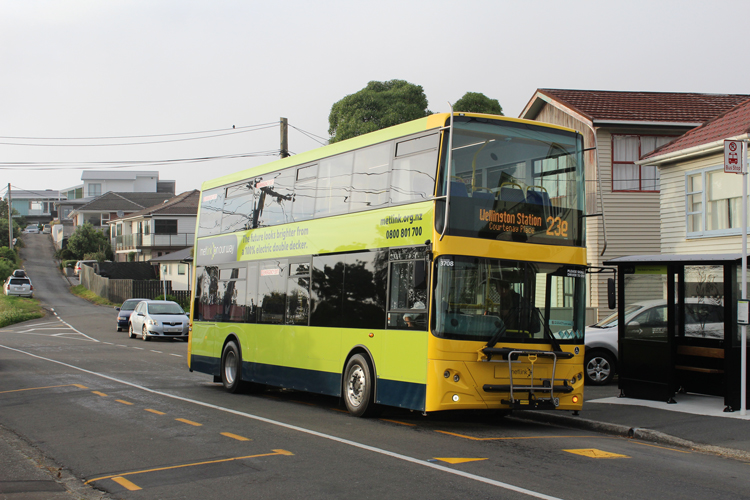Consider the impacts of topographical barriers such as hills and waterways when planning bus stop locations.
In hilly or very steep areas, bus stop spacing may need to be less than the recommended 400m to compensate for reduced walkability. Where possible, locate bus stops on a level section of the road to aid accessible movement on and off the bus. Similarly walking accessibility may be affected by waterways which could contribute to walking amenity but contribute to severance so it may be sensible to locate bus stops near waterway crossings to increase catchments.

A bus stop located in a more level location of a hilly area. (Source: Mark Edwards)
When establishing the best and most appropriate location for a bus stop it is important to remember that the Land Transport (Road User) Rule 2004 states that a vehicle must not be stopped, stood or parked within certain distances of features such as intersections, pedestrian crossings, railway-level crossings and bends.
Land Transport (Road User) Rule 2004, Part 6 (stopping and parking)(external link)
For example, a vehicle must not be stopped, stood or parked:
Although the Land Transport (Road User) Rule stipulates that within 6m is inappropriate for bus stops, we recommended avoiding them being within about 12m of pedestrian crossings and 20–60m of an intersection due to the potential for blocking sight distances. These distances are ‘rule of thumb’ guidance, so specific road factors may justify variation from them. The reason for our guidance is that the road safety of all users is paramount, and locations such as these are usually inappropriate for a bus stop.
See the illustrations in:
Be careful in considering use of traffic-calming measures (such as speed cushions and speed bumps) on the immediate approach to and departure from bus stops as they have both advantages and disadvantages for bus users.
For example, avoid speed cushions near a bus stop as passengers are likely to be standing up after boarding or before alighting and risk falling in the bus as it goes over the cushion. The underside of a bus, especially a modern, accessible, low-floor bus, may also scrape the road surface when it is negotiating heavily undulating road surfaces or traffic-calming measures. At the same time, traffic-calming measures can support safe and survivable speeds for users, especially vulnerable users, so are suitable in some contexts.
For more information on designing for traffic calming along bus routes, see:
To maintain privacy, try to avoid positioning bus stops outside the front door of residential properties.
Identify opportunities to use existing hedges or fences of private properties to give occupants privacy, without unduly compromising appropriate bus stop spacing or requiring customers to wait in secluded locations.
Some sites may be undesirable for bus stops due to potential use by conflicting activities. Undesirable sites include:
If a taxi stand and a bus stop are adjacent to one another, bus stops should be located in front of taxi stands. Positioning taxi stands in front of bus zones will result in taxis queuing back into the bus zone.
A timing point is a stop that bus drivers try to reach at the scheduled time as specified on the timetable. A bus is not supposed to pass a timing point before the scheduled time, so buses typically spend longer than usual times at timing point stops.
Where possible, locate bus timing points away from residential or other sensitive frontages where the potential for continuous noise and disturbance or visual blocking are undesirable.
Do not locate bus timing point stops across driveways. This is because under the Land Transport (Road User) Rule 2004, buses waiting at the timing point must not obstruct driveways for any purpose other than picking up or dropping off passengers.
Similarly, the Land Transport (Road User) Rule 2004 prohibits bus stop timing (that is, standing without the purpose of picking up or dropping off passengers) within special vehicle lanes. A timing point in a cycle lane makes a bus an unnecessary obstacle for cyclists, and a timing point in a bus lane prevents the lane operating to its greatest potential and may be a road safety hazard.
For further information, see clauses 1 (definitions of ‘loading zone’ and ‘parking’), 6.6 (parking in a special vehicle lane) and 6.9 (obstructing vehicle entrances and exits) and definitions of ‘loading zone’ and ‘parking’ in the Land Transport (Road User) Rule 2004:
The Land Transport (Road User) Rule 2004(external link)
The road surface is another factor to consider when selecting and managing timing point locations as longstanding idle buses may cause load-bearing issues.
For more information on road surface maintenance, including pavement design for high-stress locations to prevent rutting see:
PTDG: Corridor inspections and maintenance requirements
For more information on planning, design, implementation and monitoring for bus layovers and driver facilities, see: